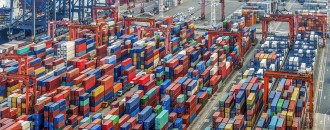
Role of Private Ports in Nation Building
 The past few years have seen a weak world economy and not much growth in terms of international trade. This has meant a difficult time for the Indian port sector, especially major ports. During FY2009-10 to FY2013-14, while traffic at non-major ports grew at a CAGR of 10%, major ports witnessed a decline in traffic. This fall can be avoided with the Indian government coming to the rescue of the ports sector.
The past few years have seen a weak world economy and not much growth in terms of international trade. This has meant a difficult time for the Indian port sector, especially major ports. During FY2009-10 to FY2013-14, while traffic at non-major ports grew at a CAGR of 10%, major ports witnessed a decline in traffic. This fall can be avoided with the Indian government coming to the rescue of the ports sector.
 Mr. Rajbir Singh Bhadana, Commodore (Retd), Group Chief Operating Officer, RAS INFRAPORT PVT. LTD.
Mr. Rajbir Singh Bhadana, Commodore (Retd), Group Chief Operating Officer, RAS INFRAPORT PVT. LTD.Capacity at major ports has not seen much growth either. In some instances, traffic has been severely impacted by the decision to ban iron ore exports. While some big capacity augmentation projects have been awarded, financing remains an issue and the private sector continues to maintain a cautious attitude. During FY2014-15, a slight improvement for major ports has been registered with a year-on-year cargo traffic growth of around 4.2%. On the other hand, the existing non-major ports, especially private ports, continue to grow due to factors such as a diversified cargo portfolio, superior operating efficiency and infrastructure, and the presence of captive cargo streams. However, the development of Greenfield ports is marred with delays due to issues related to land acquisition, approvals, etc. The industry is hoping that the situation will improve, now that a new government has taken charge. The process of obtaining environmental clearances has been streamlined. The new government is also paying attention to promoting coastal shipping and inland water transport (IWT) with the announcement of new guidelines for priority berthing of coastal vessels and the Rs 42 billion Jal Vikas Marg (NW-1) project. The planned Sagarmala project aims to shift focus from port development to “port-led development”. Special economic zones (SEZs) in Kandla and the Jawaharlal Nehru Port Trust (JNPT) have been proposed in Union Budget 2014-15. The shipping ministry plans to award 16 projects at major ports during 2014-15 with a focus on port connectivity. The government is also contemplating other changes, such as corporatisation of major ports, cabotage law relaxation, formulation of dredging policy, etc. A revision of the land acquisition act is also under way, which could speed up the development of Greenfield ports. However, certain areas still need attention. The model concession agreement document needs revision to increase the pace of project implementation. Adequate rail and road connectivity needs to be developed for seamless movement of goods. Indian ports also require deeper draught levels and improved customer service. Ports need to capitalise on the opportunities emerging from the commercial utilisation of available land; increasing tourism, LNG trade, etc. To improve operational efficiency, the mechanisation and modernisation of port facilities is crucial. Overall, there is greater awareness regarding automating cargo handling, vessel tracking, data entry, etc. Ports are increasingly deploying IT-based solutions such as enterprise resource planning, customer relation management, vessel operation management, etc. However, IT usage still remains low. In addition, new designs in port construction need to be explored for creating smarter and sustainable ports. India has 13 major ports and about 200 non-major ports. Cargo traffic, which was 976 million metric tonnes (MMT) in 2012 is expected to reach 1,758 MMT by 2017. Indian ports and shipping industry plays a vital role in sustaining growth in the country’s trade and commerce. India currently ranks 16th among maritime countries, with a coastline of about 7,517 km. According to the Ministry of Shipping, around 95% of India’s trade by volume and 70% by value takes place through maritime transport. The Indian government continues to support the ports sector. It has allowed foreign direct investment (FDI) of up to 100% under the automatic route for projects regarding construction and maintenance of ports and harbours. It has also facilitated a 10-year tax holiday to enterprises engaged in developing, maintaining and operating ports, inland waterways and inland ports. Development of a port and the associated logistics infrastructure requires big investment and the Government support. Public Private Partnership (PPP) model particularly at the State level is best suited for the purpose.
May 28, 2015 | 4:24 pm IST.





 to success.
to success.